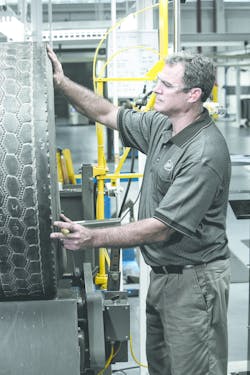How a tire is retreaded
Simply put, retreading is the process whereby selected and inspected worn tires, called casings, receive a new tread.
Only sound, carefully inspected tire casings are used for retreading. The worn tread is buffed away and a new tread is bonded to the tire body in a process very similar to the manufacture of a new tire.
Basically, there are two processing techniques used to retread a tire: mold cure and pre cure. The reason both systems exist is because of the economics of operating a retread plant has nothing to do with the quality of the finished product. Each system has unique advantages, but both systems produce equally good retreaded tires.
The initial steps in retreading a tire are the same regardless of which retreading system is used. These steps are:
1. Primary inspection. Each tire received in a retread plant is subjected to a very rigorous visual inspection. Inspectors may be assisted by the use of various non-destructive sophisticated inspection equipment available in the retread industry. Only the very best proven worn tires get past this inspection.
2. Buffing. After inspection, tires have the old tread mechanically removed on high-speed buffers. Today's buffers are extremely accurate and will remove the proper amount of old rubber while truing the tire to an exact specified diameter and radius.
3. Application of new rubber in the tread area. Here is where the systems differ.
- In the pre cure system, the tread rubber has already been vulcanized with the new tread design. The buffed tire has a thin layer of cushion gum wrapped around the tread area and the pre cured tread is then applied. The cushion gum serves to bond the pre cured tread to the tire.
The tire is then placed in a curing chamber and the pre cured tread becomes adhered to the tire through a vulcanizing process very similar to that used in new tire construction.
- In the mold cure system, unvulcanized tread rubber is applied to the buffed tire. The tire is then placed into a rigid mold which contains the tread design in the tread area. The mold is heated and the rubber in the tread area vulcanizes and adheres to the tire with the new tread design molded in.
This vulcanization process is very similar to that used in new tire construction.
Both mold cure and pre cure systems require a combination of time, heat and pressure to create the vulcanization of the new rubber to the tread area of the tire.
4. Final inspection. The retreaded tire is subjected to a final inspection to insure that only tires that meet industry quality standards are allowed to leave the retread plant.
5. Trimming and painting. The retreaded tire that successfully has passed the final inspection is trimmed to remove any excess rubber and painted. It is then ready to return to full service and another life as a safe and economical alternative to high-priced new tires.
Source: TRIB (www.retread.org). It is a non-profit industry association whose goal is to provide the motoring public – both in the private and public sectors – with the most up-to-date information about the economic and environmental benefits of tire retreading and tire repairing.
